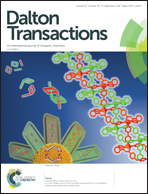15-Copper(ii)-containing 36-tungsto-4-silicates(iv) [Cu15O2(OH)10X(A-α-SiW9O34)4]25− (X = Cl, Br): synthesis, structure, magnetic properties, and electrocatalytic CO2 reduction†
Abstract
The 15-copper(II)-containing 36-tungsto-4-silicates [Cu15O2(OH)10X(A-α-SiW9O34)4]25− (X = Cl, 1; Br, 2) have been prepared in 70% yield by reaction of the trilacunary 9-tungstosilicate precursor [A-α-SiW9O34]10− with Cu2+ ions in aqueous pH 8 medium. Both polyanions 1 and 2 were isolated as hydrated mixed potassium/sodium salts and characterized in the solid state by FT-IR, TGA, single-crystal XRD, and elemental analysis. DC magnetic susceptibility measurements from 1.8–300 K established the ground state to be paramagnetic with a magnetic moment corresponding to 15 uncoupled Cu2+ (S = 1/2) ions. EPR measurements and simulations were consistent with this analysis. Electrochemical studies were performed for polyanions 1 and 2 dissolved in solution to elucidate the electroactivity of both copper and tungstate sites. Using 2 as a representative example, the electrocatalytic activity towards CO2 reduction upon deposition on a glassy carbon electrode surface, while retaining selectivity relative to hydrogen evolution, was demonstrated.
![Graphical abstract: 15-Copper(ii)-containing 36-tungsto-4-silicates(iv) [Cu15O2(OH)10X(A-α-SiW9O34)4]25− (X = Cl, Br): synthesis, structure, magnetic properties, and electrocatalytic CO2 reduction](/en/Image/Get?imageInfo.ImageType=GA&imageInfo.ImageIdentifier.ManuscriptID=C8DT01896K&imageInfo.ImageIdentifier.Year=2018)


 Please wait while we load your content...
Please wait while we load your content...